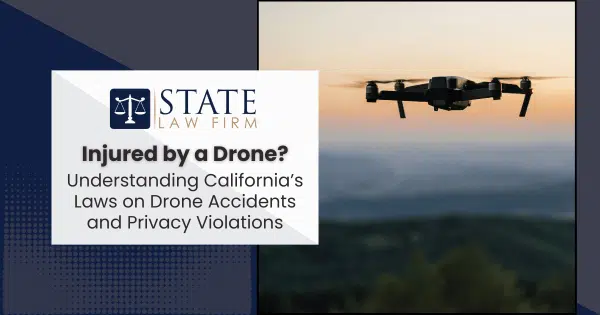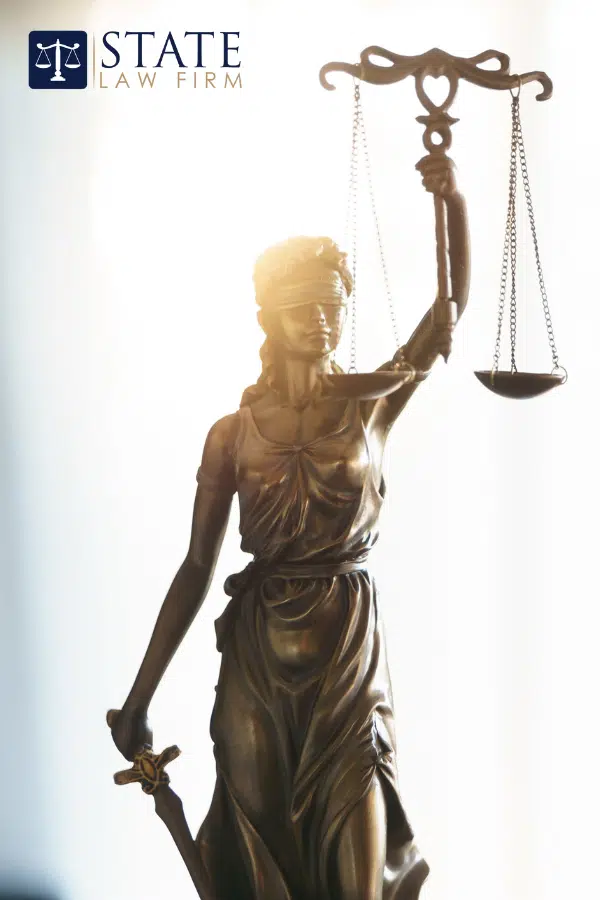Recreational drones used to feel like science fiction. Today they are everywhere, from neighborhood parks to large construction sites and Hollywood sets. As their numbers have grown, so have the risks. Recent studies estimate that thousands of people have been treated in U.S. emergency departments for drone-related injuries over just a few years, with many incidents involving propeller lacerations, head injuries, and falls caused by out-of-control devices.
California has responded with some of the strongest privacy protections in the country and a legal framework that allows victims of careless or abusive drone use to seek justice. If a drone has injured you or intruded on your private life, you may have more options than you realize. For a deeper dive, our Car accident lawyers break down what to do next and how to protect your claim.
At State Law Firm, our attorneys focus on helping real people, not case numbers. This guide explains how California law treats drone accidents and privacy violations, what qualifies as a claim, and how you can move from confusion to a plan of action.
What Qualifies as a Drone Accident or Privacy Violation in California?
A drone accident is any incident where the operation of a drone causes physical injury or property damage. In practice, we see a few common patterns:
- A drone loses power and falls into a crowd, striking someone in the head or shoulder.
- Rotating propellers slice a person’s fingers, face, or scalp.
- An operator flies too close to a road, distracting a driver and contributing to a collision.
- A drone collides with a home, shattering a window, damaging a roof, or breaking outdoor fixtures.
These are not minor events. Drone injuries can involve deep lacerations, eye injuries, concussions, and scars that affect a person’s daily life long after the flight is over.
Privacy violations work differently. They focus on how and why the drone was used. California law is especially concerned with drones that:
- Hover over a backyard, pool, or patio to record a family’s private activities.
- Peer into bedroom or bathroom windows using zoom lenses or other enhancement devices.
- Track a person’s movements around their home without consent.
When a drone enters the airspace above your land in order to capture images or sound of your personal or family life, you may be facing more than a nuisance. You may be facing an unlawful invasion of privacy that gives you a right to sue.
California Laws Governing Drone Use and Liability
Two layers of law usually matter in a California drone case: federal aviation rules and California civil law.
Federal aviation rules (FAA Part 107). The Federal Aviation Administration regulates the operation of small unmanned aircraft systems, including most drones used for work or business. Under Part 107, operators of drones under 55 pounds generally must:
- Keep the drone within visual line of sight.
- Stay under specific altitude limits in most areas.
- Avoid careless or reckless operation that endangers people or property.
- Obtain a remote pilot certificate for commercial operations and follow additional rules for flights over people or moving vehicles.
Violating these safety rules can provide powerful evidence that a drone operator acted unreasonably. In some cases, it can support a negligence per se theory where the violation of a safety regulation helps prove fault.
California privacy and property protections. California Civil Code Section 1708.8, often called the anti paparazzi statute, is central to drone privacy cases. The statute:
- Makes a person liable when they knowingly enter onto someone’s land or into the airspace above it, without permission, to capture visual images, sound recordings, or other impressions of the person engaged in private or familial activities in a way that would offend a reasonable person.
- Extends liability to the use of devices like drones and telephoto lenses, even when the operator does not physically step onto the property, if the image or recording could not have been obtained without a trespass absent the device.
- Allows recovery of general and special damages, possible treble damages, disgorgement of profits for commercial intrusions, and additional civil fines for serious violations.
Other California laws come into play as well. Local ordinances may restrict drone flights in parks or near critical infrastructure. Newer state legislation targets drones that interfere with wildfire suppression or law enforcement and considers drone based surveillance near schools and other sensitive locations. Together, these rules reflect a simple idea: you are not required to surrender your safety or privacy just because technology has made it easier to trespass from above.
Your Rights After Being Injured or Having Your Privacy Violated by a Drone
If you are harmed by a drone in California, you may have multiple legal claims, often against more than one defendant.
Negligence and negligence per se. Most injury cases start here. A drone operator who flies too close to people, ignores obvious risks, or violates FAA safety rules may be liable for failing to use reasonable care. If the operator broke a safety statute or regulation designed to prevent the kind of harm you suffered, a negligence per se theory may strengthen your case and shift the focus to causation and damages.
Intentional torts and privacy claims. When a drone is used deliberately to intrude on your private life, additional claims may arise:
- Invasion of privacy based on intrusion into private affairs or publication of private facts.
- Statutory claims under Civil Code Section 1708.8 for physical or constructive invasion of privacy, which can include treble damages and civil fines for commercial paparazzi style conduct.
- Assault or battery if the drone is used in a threatening way or physically strikes you on purpose.
Vicarious and secondary liability. The person holding the remote is not always the only party at fault. Businesses that hire drone operators to film events, real estate, or advertising campaigns can be responsible for the acts of their contractors or employees under vicarious liability theories. Event organizers and property owners may share fault if they fail to supervise drone operations or ignore obvious safety hazards.
Time limits. Most California personal injury and privacy claims must be filed within a limited period, often two years from the date of injury or invasion. Waiting too long can permanently bar your claim, even if liability is clear. Speaking with counsel early helps preserve your rights and evidence.
At State Law Firm, we take the time to untangle these legal theories, identify every responsible party, and match them to the facts of your particular incident.
Pursuing Compensation: Filing Claims and Lawsuits for Drone Related Incidents
A strong drone case starts with careful steps in the first hours and days after the incident. Consider the following roadmap.
- Protect your health first. Seek medical care immediately, even if the injury seems minor. Drone propellers and falling impacts can cause deeper tissue damage than you might expect. Medical records created right away also help tie your injuries directly to the incident.
- Document the scene. If it is safe to do so, take photographs or video of:
- The drone itself, including any visible registration number.
- Your injuries, from multiple angles and over time as they develop.
- Property damage, such as broken windows, dented vehicles, or damaged landscaping.
- Collect names and contact information for witnesses. If law enforcement responds, obtain the incident number.
- Preserve digital evidence. Drone operators often record their flights. In a lawsuit, flight logs, onboard recordings, social media posts, and text messages about the flight can all become crucial evidence. An attorney can send preservation letters and subpoenas to prevent deletion and obtain this information.
- Notify insurers carefully. Depending on the circumstances, multiple insurance policies may be involved, including the operator’s homeowner or renter policy, commercial general liability coverage for a business, or auto insurance if a drone contributed to a vehicle collision. Statements to insurers should be accurate but measured. An attorney can communicate on your behalf so your words are not twisted against you.
- Evaluate your full damages. In a drone case, recoverable damages may include:
- Past and future medical expenses.
- Lost earnings and diminished earning capacity.
- Pain, suffering, and emotional distress.
- Property repair or replacement costs.
- Loss of privacy and mental anguish from invasive surveillance.
- In appropriate cases, punitive damages and statutory fines.
When drones contribute to vehicle crashes or near miss roadway incidents, some of the same principles that govern car accident claims will apply. For a deeper dive, our Car accident lawyers break down what to do next and how to protect your claim.
Once these pieces are in place, your attorney can negotiate with insurers or, if needed, file a lawsuit in California court that clearly explains how the defendant’s conduct violated both safety rules and basic community standards of care.
Tips to Protect Yourself from Future Drone Accidents and Privacy Breaches
No one can control every careless pilot, but there are practical steps you can take to reduce risk and strengthen your position if something goes wrong.
- Be cautious around active drones. At outdoor events, construction sites, or crowded public spaces, avoid standing directly beneath drones or near obvious flight paths when you can.
- Ask questions at events or on job sites. If a contractor or vendor plans to use drones at your home, business, or wedding, ask whether the operator is properly licensed, insured, and familiar with FAA rules and local restrictions.
- Defend your privacy lawfully. If a drone repeatedly hovers over your yard, pool, or windows, keep a written log of dates, times, and what it captured. Take your own photos or short videos of the drone from the ground when possible. Contact local law enforcement or city officials rather than attempting to disable the drone yourself, since damaging it can create separate legal issues.
- Reinforce your space. Simple measures, such as strategic landscaping, outdoor shades, and interior blinds, can limit what a drone can record from common angles without meaningfully changing how you enjoy your property.
- Consult counsel early. Even if you are not ready to sue, a short consultation can help you understand whether the behavior you are seeing crosses the line from annoyance into a legally actionable invasion of privacy or hazard.
These steps do not eliminate risk, but they put you in a stronger position to respond if a flight goes wrong or an operator becomes intrusive.
Take Action if You Have Been Harmed or Had Your Rights Violated by a Drone in California
Drones have remarkable potential for good. They can document construction progress, capture beautiful aerial footage, and assist in emergency response. When misused, however, they can injure unsuspecting people and pierce the privacy that makes a home feel like a refuge.
California law does not require you to simply accept that harm. Between federal safety rules and robust state privacy protections, you have tools to hold careless and intrusive operators accountable.
If you believe a drone has injured you, damaged your property, or invaded your privacy, the attorneys at State Law Firm are ready to listen. We will review what happened, explain your rights in plain language, and fight for the compensation and accountability you deserve so you can move forward with confidence.


